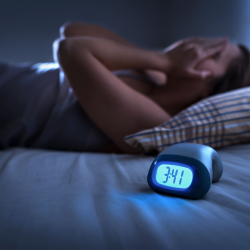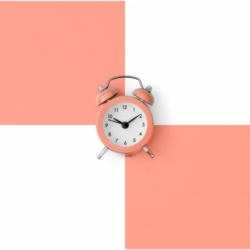Like Chronos (the god of time in Greek mythology), nothing is constant in our environment. We don’t operate in a simple or linear fashion, but we operate in a rhythmic fashion. Moreover, certain environmental disturbances modulate our biological rhythms. The study of biological rhythms or chrono-health is a scientific discipline born about 30 years ago. Eating behavior has been the subject of numerous studies aimed at defining its rhythmic organization. The consequences of the rhythms of food consumption on bodily physiology are ultimately numerous.
Why do biological rhythms influence the choice of food?
Rhythmic variations in nutrient preferences meet physiological needs; carbohydrates meet immediate energy needs at the start of the waking period, while the consumption of protein and fat towards the end of this period is an anticipatory intake directed towards the storage of nutrients for their use during the period of sleep. In addition to our physiological needs, the time of day also has an effect on our sensory preferences, especially for the texture of food.
The periodicity of eating behavior:
We do not eat continuously or randomly on the 24-hour scale. Our eating behavior varies periodically or rhythmically. Indeed, we eat and drink according to schedules structured in time. It is during our waking period that we ingest food and drink, while during our sleep period we neither eat nor drink.
We combine food and drink into meals of different sizes and consumption at different intervals. The sequence and composition of meals varies predictably and periodically. Although our diet depends on many physical, social and cultural stimuli, there are temporal rhythms in our nutritional preferences.
What is a biological rhythm?
A biological rhythm is the periodic variation of a physiological function in a living organism. At the cellular level, this notion translates into a rhythmic distribution of energy, ensuring one synthesis after another and thereby distributing biochemical functions over time. On the organic scale, this rhythmic succession results in variable functioning of the organ.
The rhythms are based on a genetic and environmental component. Man indeed has an endogenous rhythm of its own, with a stable period, well known from the experiences of isolation. The period of this rhythm, called “free flow”, encoded on chromosome 4 where the locus containing the clock gene has been identified, is estimated at 24 hours and 11 minutes. It is on this genetic basis that the environment intervenes through an internal biological clock. This is in fact adjusted to external synchronizers such as day / night alternation or climatic variations and, by creating an interface with endogenous rhythms, ensures the phasing of the body with its biotope. This clock, also known as the “internal oscillator”, is located in humans at the level of the hypothalamus.otálamo.
Chrono-physiology:
Chrono-physiology is the analysis of human physiology through the lens of time. It helps identify metabolic, neurological or endocrine functions that are triggered only at certain times each day, to prepare the body for a predictable event.
This is the case with the endocrine system rich in chrono-modulated functions:
- The adrenal glands, for example, secrete cortisol in an amount five times greater in the morning between 6 and 8 a.m. compared to the night (by the hyperglycemia that it causes, this hormone prepares muscle function when waking up and avoids the weaknesses that ‘a night without food intake could have induced)
- The thyroid gland secretes the maximum amount of thyroxine in the morning around 9 a.m. (preparing the brain for the stress of the day)
- The pancreas secretes insulin in a pulsatile fashion outside of the diet (ensuring carbohydrate storage in line with physical activity)
- The pineal gland only secretes melatonin at night (conditioning sleepiness)
- The pituitary gland secretes twice as much growth hormone at night as during the day (ensuring the child’s bone growth at rest and participating in nighttime glycemic stabilization)
- The ovaries have a monthly secretory periodicity in estrogen (regulating the periods of female fertility)
Chrono-pathology:
If there are physiological endogenous rhythms, their disruption can generate chrono-pathologies, terminology denoting the temporal decoding of symptoms. Of course, not all human pathologies can be studied from this angle, but this approach can enrich our perception and our understanding of diseases. A few examples illustrate the principles:
- The blood sugar oscillations of the diabetic
They are thus expressed according to a rhythm common to all patients. Its translation, regardless of any diet, draws a constant acrophase between 8 and 10 a.m. in the morning and between 8 and 11 p.m. in the evening, while the glycemic nadir is between 4 and 6 p.m. in the evening and 2 and 4 a.m. in the morning. This rate is a direct consequence of that of the secretions of cortisol, adrenaline, thyroxine, growth hormone and the rate of tissue insulin sensitivity.
- Seasonal depression
Another example of dysrhythmia is seasonal depression, characterized by mood disturbances that begin in the fall and disappear in the spring. Considered as a pineal dysfunction resulting in an inappropriate reaction to the decrease in luminosity occurring during the winter period, it leads to too high daytime melatonin levels. A phase shift, hypersomnia and a chronic depressive state result. Light therapy therefore restores endocrine balance by inhibiting this inappropriate secretion of melatonin, which helps improve mood.
- Paroxysmal asthma attacks
They can be a final example of chrono-pathology, by their preferential occurrence between 9 p.m. and 5 a.m. It is indeed during this period that the bronchial sensitivity to irritant factors is maximum due to the physiological decrease in the bronchial diameter caused by the secretory batyphase in adrenaline, norepinephrine and cortisol, combined with the increase in both vagal tone and bronchial sensitivity to histamine.
Chrono-nutrition:
Chrono-nutrition is a way of eating while respecting the hormonal and enzymatic secretions of the body.
This diet is based on the body’s hormonal and enzymatic secretions, which vary depending on the time of day:
- In the morning, it is recommended to eat fat and protein since the secretion of lipases and proteases is important at the start of the day.
- In addition, at noon it is recommended to have a meal rich in proteins and slow carbohydrates since proteases and amylases are secreted significantly at this precise moment.
- During the afternoon, the spike in blood cortisol will generate hypoglycemia, which will be limited if you take fruit or sweet products at that time.
- Finally, in the evening, the digestive secretions are weak, which implies a lighter dinner and based on vegetables and lean proteins.
Chrono-nutrition is more a way of life than a diet. It is about eating while respecting the physio-biological needs of the organism. There is therefore no time limit. Good eating habits should be maintained for life, even after reaching the desired weight.
Sources :
- Thibault, L, Booth DA : Macronutrient-specific dietary selection in rodents and its neural bases. Neurosci Biobehav Rev 23:457, 1999.
- Expertise collective Inserm, Rythmes de l’enfant : de l’horloge biologique aux rythmes scolaires, 2001.
- Osseni R.A., « Circadian rhythms of glutathione and mitochondrial activity in human hepatic cell line. Influence of melatonin », in : Biological Clocks, Mechanisms and Applications, Elsevier Science, 1998.







